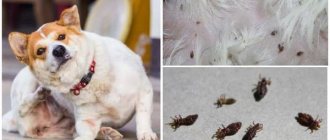Having pets, in particular dogs, according to various studies, lengthens a person's life and makes him healthier. This is understandable, because you need to walk the dog, which means going out into the fresh air more often, spending less time on the couch in front of the TV, and spending less time on gadgets. It should be understood that dogs can act as a source of various infections that can also infect humans. Therefore, it is worth finding out in advance what you can “catch” from your pet, in particular a dog, and how you can prevent the possibility of infection with certain pathologies. After all, a healthy animal will give a lot of joy and positive emotions.
Echinococcosis
Rospotrebnadzor distributed a leaflet reminding about the potential danger for humans of contracting echinococcosis from dogs. The memo was compiled as part of the preparation of a draft resolution on behalf of the chief sanitary doctor of Russia “On preventing the spread of echinococcosis in the Russian Federation.”
Related article: Do dogs get depressed? How people and their pets are related According to the department, a person can become infected with this disease through contact with sick animals, in particular dogs, when collecting and eating wild berries and herbs, as well as through consuming contaminated water. It is worth understanding that echinococcosis is essentially a parasitic disease. It is caused by tapeworms of the same genus. When infected, the larvae enter the liver; less often, they can move to the lungs and other organs. Against the background of their vital activity, cystic formations containing parasite larvae develop in the human body. As a rule, the disease is detected in the early stages using instrumental examination or during surgery. Moreover, parasites can live for decades before clinical signs appear in the human body.
Among the symptoms that indicate echinococcosis:
- jaundice;
- liver enlargement (determined by palpation or ultrasound);
- pain that radiates to the arm or back;
- a feeling of heaviness and compression on the right hypochondrium;
- dyspnea;
- cough;
- chest pain, etc.
It is worth understanding that the disease can be fatal, and often as a result of it a person is assigned a disability. You can avoid infection. It is enough to observe simple hygiene, i.e. wash your hands after contact with the dog, do not let it lick anything from your food, minimize situations when the dog licks its face or often stays on the sofa or bed of its owner, especially if it regularly does not undergo antiparasitic therapy.
Mythical dangers.
Wrong helminths.
Opisthorchiasis (caused by the cat fluke), clonorchiasis (caused by the Chinese fluke), diphyllobothriasis (caused by the tapeworm), teniarinchiasis (caused by the bovine tapeworm) and many other helminthiases cannot be contracted directly from an animal, although it can serve as a home for the parasite and be thrown into There are many eggs in the environment. These helminthiases are dangerous for humans, but they can only be contracted from an intermediate host by eating fish or meat.
Not that flu.
Influenza-like diseases are caused by rhinotracheitis and calicivirus viruses in cats, and in dogs by parainfluenza (kennel cough), canine distemper and some others. Unlike the notorious “bird flu” and “swine flu”, these viruses are not noticed in “humanity” and are dangerous only for certain types of animals. But you should be careful when treating respiratory diseases of your pets - they are sometimes complicated by bacterial flora, but this can be dangerous for people with reduced immunity.
Not the same AIDS.
The feline immunodeficiency virus is a deadly enemy for cats, but it is not dangerous for humans. In general, most of the viruses that infect our pets are species specific. Rabies is one of the few sad exceptions.
Wrong lice
Lice are species-specific parasites. Three types of lice have been found in humans - body lice, pubic lice and head lice. Cats and dogs are parasitized by their own lice, which are not dangerous to humans. But if there is no choice, cat fleas can bite a person.
Not that chlamydia.
The most common chlamydia in humans is a disease caused by Chlamydia trachomatis. It has nothing to do with Chlamydophila Psittaci or ornithosis. Chlamydia trachomatis is transmitted sexually and sometimes through household contact, but you will never get it from an animal.
We sincerely wish you and your pets good health. And if someone frightens you about the incurable consequences of your friendship with a cat or dog, do not hesitate to ask questions to specialists.
Staphylococcus
One of the most common bacteria, which most often enters the human body through household routes, can also be transmitted to him from a pet. Staphylococci are gram-positive bacteria and can lead to the development of various inflammatory processes in both animals and humans. In dogs, staphylococcal infection usually develops against the background of other diseases accompanied by itching. At the moment when the dog begins to scratch too actively and chew the skin, infection enters through the wounds and foci of suppuration form.
People get infections from dogs the same way - through wounds on the skin. The elderly and children, as well as those who cannot boast of strong immunity, are most susceptible to infection from a pet. Infection occurs through normal contact, when the animal is petted and then not washed, if the animal in the game bit the owner before the injury appeared, etc. Pathology can be excluded by caring for the dog, checking its health, monitoring, for example, whether She has pockets of infection on her body, giving her the necessary vaccinations. And, of course, regular hygiene is required, i.e. the same usual hand washing. If there are wounds on the skin, you should be very careful in contact with your pet.
According to dog laws. How to avoid becoming a victim of four-legged animals? More details
Sources
- De Martel C., Ferlay J., Franceschi S., Vignat J., Bray F., Forman D., Plummer M. Global burden of cancers attributable to infections: a review and synthetic analysis. The Lancet. Oncology. June 2012, 13 (6): 607–15.
- De Paoli P., Carbone A. Carcinogenic viruses and solid cancers without sufficient evidence of causal association. International Journal of Cancer. October 2013, 133(7): 1517–29.
- Mager DL Bacteria and cancer: cause, coincidence or cure? A review. Journal of Translational Medicine. December 2006, 4 (1): 14.
- Pagano JS, Blaser M., Buendia MA, Damania B., Khalili K., Raab-Traub N., Roizman B. Infectious agents and cancer: criteria for a causal relation. Seminars in Cancer Biology. December 2004, 14 (6): 453–71.
- Samaras V., Rafailidis PI, Mourtzoukou EG, Peppas G., Falagas ME Chronic bacterial and parasitic infections and cancer: a review. Journal of Infection in Developing Countries. June 2010, 4 (5): 267–81.
- Stewart BW, Wild CP Cancer etiology. World Cancer Report 2014. World Health Organization. 2014, pp. 16–54.
- Wu S., Powers S., Zhu W., et al. Substantial contribution of extrinsic risk factors to cancer development. Nature. 2016. Vol. 529, no. 7584. P. 43−47.
- Kiselev F.L., Imyanitov E.N., Kiselyova N.P. Molecular oncology. From viral theory to cancer treatment. Moscow: GEOS, 2013, 151 p.
Rabies
Perhaps one of the most deadly viral diseases that can be contracted from a pet. It is worth understanding that you are more likely to catch the virus from a stray dog. However, cases of diseases among domestic dogs cannot be excluded. For example, if the owners do not monitor the health of their pets and do not get all the necessary preventive vaccinations on time.
The rabies virus is a neurotropic virus. In animals, the disease can occur in 3 types. If we are talking about the violent version, then the dog will be lethargic and fearful at first, and later too affectionate and intrusive, then its state will change to overly aggressive. She may react poorly to bright lights, noise and screams, she begins to drool, and begins to howl. A distinctive feature of rabies is the inability of the animal to swallow water.
In a quiet form, the dog tries to lick the owner, after which drooling and restlessness begin, again it is difficult to swallow. In the atypical form, symptoms such as signs of inflammation in the gastrointestinal tract are spoken of.
The virus is contained in a dog's saliva, and it can migrate to a person through obsessive licking by the pet, especially if there are wounds on the skin. The incubation period in humans lasts up to 40 days, but can be longer - up to a year. The higher the bite or wound through which the infection has passed, the faster the pathology will develop.
Article on the topic
Benefactor of humanity. How Louis Pasteur created the first vaccinations First, nagging pain begins, itching begins, the temperature rises (albeit to low numbers), nightmares develop, and problems with sleep and appetite appear. At the second stage of development of the pathology, hydrophobia begins, breathing becomes convulsive, causeless fear of everything appears, the pupils dilate, and salivation appears. The last stage is a violation of sensitivity and muscle paralysis, the temperature rises significantly and goes off scale beyond 42 degrees, the pressure drops, and the heart, on the contrary, beats more and more strongly. This stage ends with the death of a person.
Today, if contact with a rabid animal is suspected, a person is given a special vaccination, which immediately suppresses the infection and prevents it from developing. From the point of view of prevention, you just need to monitor your pet, vaccinate it and not come into contact with wild street animals.
Also among the potential dangers to humans from dogs are tuberculosis, distemper, and scabies mites. It is worth understanding that if a dog is well cared for, regularly visits a doctor and undergoes all necessary examinations and vaccinations, then the likelihood of a person contracting all these unpleasant infections tends to zero. But still, you should not forget about the rules of personal hygiene, regularly wash your hands, avoid too close contact, such as licking by an animal, and do not forget about proper disinfection.
Unpleasant surprises from nature
Many of us truly love animals. We perceive our pets as family members, often not really thinking about our own safety. But the idyll can be destroyed if minimal precautions are not taken. It is naive to believe that the tailed inhabitants of our apartments are one hundred percent protected from all kinds of diseases. They are by no means isolated from the environment. Even after an ordinary walk, they can bring some kind of “sore” into the house, which can cause a lot of trouble not only for the pet, but also for you and your household. And if you are going out of town, remember that only vaccinated animals can be taken out into the wild, otherwise, when faced with their wild counterparts, our pets can become a source of disease for us.
Dermatomycoses
The largest group of infections that can be “caught” from animals. Most often these are fungal diseases, various mycoses, and lichens. There are a lot of them, they have the same external manifestations on both pets and humans. It is only important to make the correct diagnosis, since different types and types of dermatomycosis require specific treatment.
...plague?
Distemper, canine distemper, or Carré's disease, is very dangerous for dogs. The disease progresses rapidly and is often fatal.
However, a dog cannot infect a person. Despite the fact that the course of the disease, canine plague is similar to measles in humans, it does not pose a danger to humans. Cat owners should not worry - this disease is typical only for dogs.
The bad news: sometimes a person can infect a dog! For example, bringing the virus on contaminated shoes or clothes.
Important: this disease is very dangerous for dogs, but there is an effective way to prevent it - vaccination. Be sure to consult with your veterinarian to find out which vaccination schedule is best for your pet.
"Dogs can be biting..."
The main “reservoir” of the rabies virus is dogs, cats, wild animals, especially foxes. A sick animal behaves unusually: a domestic pet can become aggressive and refuse water and food, and vice versa, a wild animal is not afraid of people and comes out to them. To prevent rabies, pets must be vaccinated. Infection of a person occurs when a sick animal bites or its saliva gets on the mucous membranes and damaged skin, so if you are bitten by a dog or any other animal, the first thing you need to do is wash the wound with plenty of soap and water. There is no need to bandage or clamp the wound - the flowing blood will wash it away from the animal's saliva. But if a large blood vessel is bitten, this method is not applicable. And most importantly, if you are bitten by an animal, immediately consult a doctor at the emergency room at your place of residence! You can forget about the painful forty injections in the stomach - the new generation vaccines are injected into the shoulder and only six times. It should be remembered that rabies is a fatal disease, but timely vaccination actually prevents its development.
Helminthiasis
Worms are a common problem in dogs, puppies and animals brought in from the street. Young animals love to taste objects or scraps found on the ground that may be infected, so this behavior must be stopped and trained from a young age.
The source of infection can be not only garbage, but also feces, dirt, and other animals in close contact. Helminths such as pinworms or roundworms are often found, but echinococcosis or toxoplasmosis can cause serious harm. Both diseases negatively affect the health of humans (and dogs too) and require complex treatment.
Toxoplasmosis is most often transmitted by cats, but dogs can also be a source of infection. For an adult, the disease is not too dangerous. Pregnant women are at risk, as microorganisms can cause miscarriage.
Even roundworms with pinworms are harmful to health if they infect a small child. The infestation can affect his physical and mental development.
Infected dogs are sources of such dangerous parasitic diseases as toxocariasis, dipylidiasis, alveococcosis, and diphyllobothriasis.
Speckled skin
Microsporia or ringworm is one of the most common skin diseases of animals. When people become infected from them, people also get sick: small spots appear on the skin, covered with gray scales; there can be from two to a hundred of them on the human body. The causative agent of microsporia also affects the hair, so sometimes during treatment the head has to be shaved, which is very unpleasant for the patient. If you notice even a slight redness in the shape of a circle or ring, do not be lazy - go to a dermatologist. If time is lost, curing the disease will be much more difficult.
... tetanus?
The causative agent of tetanus is introduced into the body through open wounds from the environment, for example, from the soil. Therefore, untreated deep bite wounds and other skin injuries are equally dangerous for the pet and the owner.
Important: even a minor open wound can lead to infection of the dog. After each walk, a thorough examination of the skin and antiseptic treatment of cuts and abrasions is recommended. Be sure to contact a specialist if you notice symptoms of the disease in yourself or your pet.
Disease on bird rights
Indoor birds (budgies, canaries and other small songbirds) can be a source of infection with psittacosis (pneumochlamydia). People who usually have constant contact with birds get it. When infected at home, family outbreaks can occur. Infection occurs by airborne droplets - when particles of bird feces are inhaled with dust while cleaning cages. The disease usually occurs 5–10 days after an infected bird appears in the house. If your feathered pet has been living with you for several months, then most likely it is healthy and infection is unlikely (if during this time there has been no contact with other birds). A sick person develops chills, headache and muscle pain, an increase in body temperature to 38-40 degrees, a dry cough and sore throat. On the fifth to seventh day, chest pain, shortness of breath, cough with bloody mucous sputum, and signs of pneumonia appear. A person suffers from insomnia and dizziness. If you do not consult a doctor in time, subsequent relapses and the disease may become chronic. The danger of the disease should not be underestimated, therefore, when the first signs of illness appear, you should immediately see a doctor.











